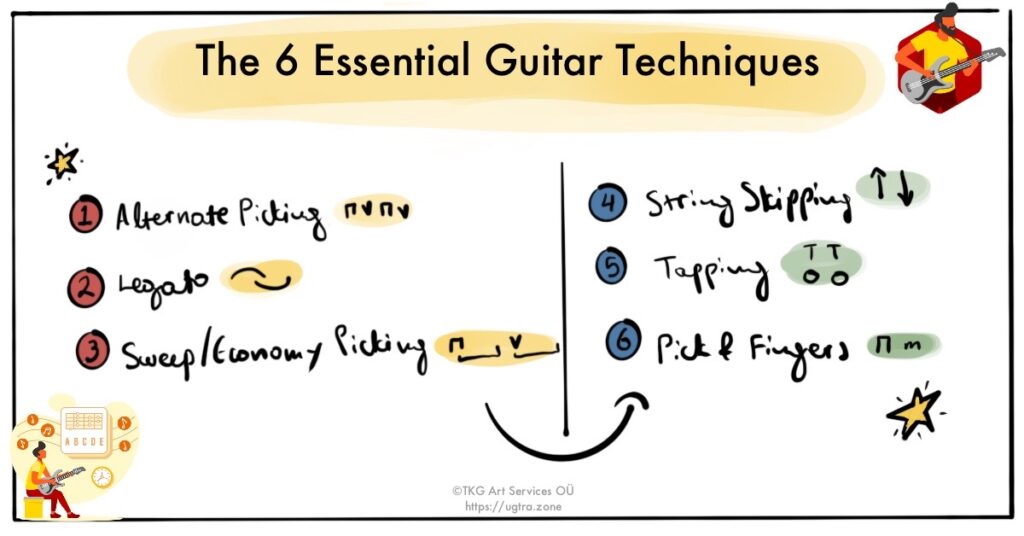

[The 6 Essential & Advanced Electric Guitar Techniques is the Part II of an article series regarding guitar techniques in detail. If you haven’t read Part I yet, click the link, it’s a must-read: The 8 Most Important (And Easy) Guitar Techniques.]
If you’ve already read my story, you probably know that I took my first lesson at the age of 21.
There is a nice side story about how I started practicing consistently electric guitar technique, that I haven’t included it in the original post.
I always enjoy sharing it with my students.
It was the end of August 2003.
The last days of my holidays before getting back to Volos, where I was studying architecture.
The schedule was going to be extremely busy as I had almost a month of examinations ahead and then starting the new academic year.
During these days off, I had the chance to take my first 2 lessons from my coach (and then my good friend) Ioannis Anastassakis.
From the right beginning he told me:
“In order to guarantee results, I want you to practice the guitar technique exercises for at least an hour every day”
He gave me the first set of exercises.
They were single-string Alternate Picking and Legato ones.
I left, and I promised myself that I’m gonna follow this rule no matter what.
Returning to Volos, I got busy from the very first minute.
The preparation for my exams was demanding.
Many group exercises, technical drawings, exams…
I had to spend a lot of hours outside my house.
I had a promise to keep though.
I had to practice at least an hour per day.
So, no matter what, I was finding 60′ during the day, grabbing my guitar, and practicing with metronome 6 exercises.
3 Alternate Picking and 3 Legato – 10′ each.
That’s it.
When that was over, I was placing the guitar down, till the next day.
No jamming, no noodling, no playing songs.
Just poor technique practice.
That was my routine for about a month.


The a-ha moment
After finishing my exams, I invited 2 friends to come to my place.
It was the first time that we had free time to hang out.
That was the first time since starting practicing the technique that I had the chance to grab my electric guitar and play some improvised lines.
And that was when it hit me.
My fingers were like they had upgraded.
Both hands synchronized, my notes were clear, my fingers accurate…
“This is what happens if you practice technique?”, I wondered.
Since then, I increased my practice hours to one and a half (technique only) and kept that promise for about 5-6 years in a row.
Now, almost 20 years later, I still call my coach after big shows and recordings and thank him for opening that door to me.
I’m grateful that I can enjoy playing the guitar and participating in challenging projects without worrying about my technique.
An advanced technique skillset gives confidence and minimizes the “distance” between the music we have in our minds and our fingers.
That’s why I recommend to all my students, to commit and make the same promise to themselves.
Practice technique consistently.
Below, I’m gonna analyze the electric guitar techniques all contemporary guitarists need to know.
The Essential Electric Guitar Techniques
1. Alternate Picking
2. Legato
3. Sweep / Economy Picking
4. String Skipping
5. Tapping
6. Pick & Fingers (Hybrid Picking)
1. What is the Alternate Picking
This technique creates the most “mathematical” and “articulated” sound.
The concept is simple.
Alternate your picking direction between downstrokes and upstrokes.
This is an inviolable rule either you play single or multiple string lines.
It’s also a technique that allows us to increase speed as we take the advantage of using both sides of the pick.
It’s considered the most fundamental technique, you can find it in endless guitar licks, and it’s the one that should be implemented when we practice scales, in order to create a balanced and articulated sound.
Tips
1. Use your wrist and not your elbow to alternate the pick directions.
2. Your picking hand should rest on the strings, the opposite of what you do when strumming chords.
Some guitarists prefer to rest their hands on the upper strings from the one they pluck, while others on the lower ones.
[Some do both depending on what they play]
This is crucial because that way, we mute the unwanted strings and noises, especially when playing with distortion.
Read more 👉 How To Improve Your Alternate Picking. A Strategic Approach to Master the most Common Guitar Technique.
2. What is the Legato
Legato is the opposite of alternate picking.
It means “tied together” and describes that the notes should follow one the other as smoothly as possible.
In guitar playing, we achieve that by a combination of hammer-ons and pull-offs using the fingers of our fretting hand only.
That way, the notes are tied together without articulating each one by picking them.
Tips
1. A common mistake between beginner and in some cases intermediate guitar players, is to use the wrist of the fretting hand to help the fingers motion.
Use only your fingers while keeping your fretting hand’s palm always parallel with the neck.
2. Hit the notes right before the fretwires.
3. Use your pick only at the start of a legato phrase or when changing strings. Even better, use “hammer-ons from nowhere” for even smoother results.
4. Listen to everything from Allan Holdsworth ( Holdsworth uses hammer-on from nowhere all the time)
Learn more about the art of legato 👉 The Architecture of Legato Guitar Playing: Designing Smooth Guitar Lines
3. What is the Sweep Picking / Economy Picking
Sweep picking can be considered as a legato version of the alternate picking.
On the contrary alternate picking keeps the same picking direction when changing adjacent strings.
So, if you move from the lower to higher strings, use a single down stroke.
In the opposite case, use an upstroke.
[Of course, when playing notes on the same string, use alternate picking or legato].
That way, the notes’ attack becomes smoother, while the articulation is not so strict as in the alternate picking.
It’s a common advanced technique, especially when playing arpeggios.
Tips
1. Use a single motion when sweeping the pick vertically across the strings. Don’t use your wrist. Use your elbow instead to create a smooth movement from string to string.
2. Listen to everything from Frank Gambale.
Further Reading 👉 Alternate Picking vs Economy Picking: Which Picking Technique Suits Your Playing Style Best?
4. What is the String Skipping
One of my favorite techniques as it creates large intervals and breaks the scalar melodies that are common among beginner or in some cases, intermediate guitarists as well.
As the name indicates, we skip strings as we play melodies.
It creates unpredictable, intervallic lines that keep the audience’s attention.
It’s considered an advanced guitar technique, as it might usually combine other techniques (such as alternate picking, legato, or even tapping) and effective muting of the unwanted strings.
Tips
1. Keep your fretting hand’s palm always parallel with the neck.
2. Don’t use your wrist to help your fretting hand’s fingers.
3. Use both hands to mute the unwanted strings (the picking hand to mute the strings above the one you play and the left to mute the below ones).
5. What is the Tapping
Think tapping (or two-hand tapping) as an extended legato.
You need to play a large interval on the same string using a hammer-on or a pull-off, so you use your picking hand’s middle finger to tap the highest note on that string.
Tapping has a huge advantage compared to the other techniques.
We can reach fast tempos without needing extreme guitar skills.
This is possible as it shares the fretting notes between both hands so playing fast legato lines becomes easy.
Tip
1. Keep holding the pick when practicing tapping. You need to put it organically into your playing without producing a timbre gap when changing techniques.
2. Tap the note using the middle finger of your picking hand using the hammer-on & pull-off principles we discussed in the part I of this article.
6. What is the Pick & Fingers (Hybrid Picking)
The hybrid picking technique is used in all styles of music by most advanced guitar players.
It’s very convenient and a powerful expression tool.
We can jump from string to string easily without needing to create large vertical movements with our picking hand.
Just use your pick on one string and the middle and ring finger on the others to quickly jump vertically across the strings.
The timbre is a combination of articulated notes (the ones we use the pick) and less attacked ones (the ones that we used our fingers).
Listening to everything from the master Brett Garsed is a must.
Tips
When using the hybrid picking technique, we tend to accent the picking note more than the fingered ones. Try to balance the accents in order to produce a smooth, fluid effect.
If you want to decode all the guitar techniques and improve your lead playing, book a session no matter your guitar playing level or musical style!
